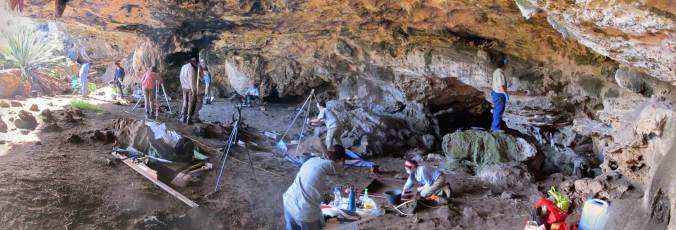There’s an ancient limestone spine that runs along Australia’s southwestern coastline. Formed by sand dunes that have compacted and lithified over time, the Tamala limestone formation is covered by forest, woodland thickets, and low coastal shrubland known as kwongan. Caves scar the spine from its northern tip all the way south to Augusta in Western Australia’s far southwest. Most aren’t easily accessed by people: they are fissures in the ground that open into dark, deep tunnels and caverns. But in some places, erosion has opened cave entrances until they are large enough to walk into. Many West Australians are familiar with the ‘show caves’ of the Augusta-Margaret River region, but fewer know of the smaller, more secluded caves that pockmark the coastal plain north of Perth.

Caves provide shelter to people and animals, making them ideal places to look for evidence of past activity.
Caves are archaeological and palaeontological time capsules. As well as being protected from the harsher environmental conditions of the surrounding sandplains, the caves collect a record of human activity, combined with activity from animals like owls, dingos, and extinct predators the thylacine (Tasmanian tiger).
In late 2014, I worked with a team of Amangu elders, undergraduate university students, volunteers, and cavers to investigate some caves a few hours north of Perth. Archaeological excavations often feel like a gamble: you can plan and survey a site to your heart’s content, but it’s only when you start to dig that you’ll know what is hidden in the ground. In this case, we had placed our bets on two particular locations within the cave that looked most promising. We aimed to excavate small samples of material; to collect animal bones, evidence of hearth fires lit by Aboriginal people, and stone tools that might tell us about who used these caves and why. Luckily for us our bets paid well. Moments after scraping back the top layer of sediment we found our first stone tool: a small flake of white quartz.
Over two weeks, we excavated almost four tonnes of sand, ash, bone, rubble, emu eggshell, and artefacts from two small pits. We collected samples of bone and sediment to test for ancient DNA, and spoke to the elders about how Amangu people used the plants and animals of the coastal plain. We collected charcoal for radiocarbon dating, and surveyed the area around the cave to record the plants that currently grow there. We also recorded some evidence of historic activity: a couple of pieces of broken glass, an old farrier’s file, and graffiti scratched into the limestone wall.
Our plan had been to excavate a second cave nearby – one that wasn’t easily accessed by people but would give us an insight into the past environments. This would give us a ‘control’ with which to compare the findings from the first excavation, and would help us separate human activity from that of dingos, owls and other predators. But because our first site was so rich in animal bone and cultural material, that excavation consumed all of our available time. Archaeological evidence from this part of the southwest coastal plain is rare, so we dedicated our time and resources to maximising our archaeological results. Now, we need help to fund a return trip.
How does archaeological research help us preserve biodiversity?
Research like this has benefits not only for understanding Aboriginal cultural practices, but also understanding past ecosystems. Since European arrival, plants and animals across Australia have become endangered and extinct at an astonishing rate. The combination of introduced predators, destruction of habitat, and changes to fire regimes has devastated ecosystems. Palaeoecological evidence allows us to reconstruct past environments and examine environmental trends. Archaeological evidence helps us to understand Aboriginal use of landscapes, plants and animals. When we examine these two strands of evidence together, we can begin to understand the influences of Aboriginal activity on the environment. This helps us to identify the consequences of Aboriginal burning on the plant and animal communities, and whether certain species (such as kangaroos, possums, quandong trees, or yams) were being deliberately managed. Importantly for modern conservation efforts, this information can help to highlight management strategies that might benefit endangered species.
You can help us
We’re seeking financial support to get us back in the field this year and cover lab costs associated with dating changes in environmental conditions and cultural practices. This will help us create a framework for investigating how environments and Aboriginal cultural practices changed through time, and will mean that we can identify the impacts of these changes on the associated ecosystems.
For more details about our crowdfunding campaign, visit our page on Chuffed.org: How nature and nurture created biodiversity in south-western Australia. We think that this research is interesting and important. We’d love your support.

